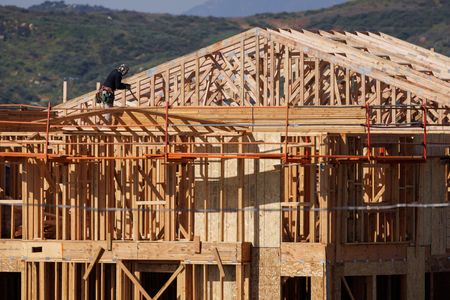By Lucia Mutikani
WASHINGTON (Reuters) – U.S. single-family homebuilding fell to an eight-month low in June amid higher mortgage rates, suggesting the housing market was likely a drag on economic growth in the second quarter.
The report from the Commerce Department on Wednesday also showed permits for future construction of single-family houses dropped to a one-year low last month, indicating that any anticipated rebound in activity, if the Federal Reserve cuts interest rates in September as expected, could be muted.
Nonetheless, new construction remains underpinned by a shortage of previously owned houses for sale. That is keeping home prices elevated and combining with higher borrowing costs to push homeownership, long viewed as the American dream, out of the reach of many.
The housing market has been hardest hit by the U.S. central bank’s aggressive monetary policy tightening to quell inflation.
“The country is not building enough single-family homes to alleviate the shortage of affordable housing and this is guaranteed to further inflate the housing price bubble and make the cost of buying a new home even more unaffordable,” said Christopher Rupkey, chief economist at FWDBONDS.
Single-family housing starts, which account for the bulk of homebuilding, fell 2.2% to a seasonally adjusted annual rate of 980,000 units last month, the lowest level since last October, the Commerce Department’s Census Bureau said.
Data for May was revised higher to show starts for this housing segment dropping to a rate of 1.002 million units instead of the previously reported 982,000 units.
Single-family homebuilding fell in the Northeast and the West, but increased in the densely populated South and the Midwest, which is considered a more affordable region.
Single-family housing starts increased 5.4% on a year-on-year basis in June. Homebuilding was strong for much of last year and through the first quarter of 2024 amid a dearth of previously owned houses for sale.
Momentum, however, fizzled as the average rate on a 30-year fixed-rate mortgage pushed back above 7% in April against the backdrop of high inflation and a strong economy.
With inflation subsiding and financial markets expecting a rate cut in September followed by additional cuts in November and December, mortgage rates have been trending lower.
The rate on the 30-year fixed-rate mortgage averaged 6.89% last week, having dropped from a six-month high of 7.22% in May, data from mortgage agency Freddie Mac showed.
Though homebuilder confidence dropped to a seven-month low in July, the National Association of Home Builders’ measure of single-family sales over the next six months improved.
But concerns about slowing economic activity, following a recent rise in the unemployment rate, could make builders more cautious about breaking new ground on projects.
Stocks on Wall Street were trading lower on prospects of tighter U.S. trade curbs on companies giving China access to advanced semiconductor technology. The dollar fell against a basket of currencies. U.S. Treasury yields rose.
RESIDENTIAL DRAG
Economists estimated that residential investment, which includes home building, likely subtracted from gross domestic product last quarter, after adding more than half a percentage point in the January-March quarter.
The Atlanta Fed is forecasting GDP increasing at a 2.7% annualized rate in the second quarter. The economy grew at a 1.4% pace in the first quarter. The government is scheduled to publish its snapshot of the April-June quarter growth next week.
“The reductions in interest rates that we expect later this year likely will be a mixed blessing for the residential construction sector overall, as we think the Fed will be responding to rising unemployment, which will curb the flow of new buyers,” said Ian Shepherdson, chief economist at Pantheon Macroeconomics.
Permits for future construction of single-family homes slipped 2.3% to a rate of 934,000 units, the lowest level since May 2023. Starts for housing projects with five units or more soared 22.0% to a rate of 360,000 units in June. Overall housing starts advanced 3.0% to a rate of 1.353 million units.
Economists polled by Reuters had forecast starts would rebound to a rate of 1.300 million units. Starts were down 4.4% from a year ago. Multi-family building permits surged 19.2% to a rate of 460,000 units. That contributed to lifting building permits as a whole by 3.4% to a rate of 1.446 million units.
The multifamily housing market segment continues to benefit from the shift to renting from buying.
The number of houses approved for construction that were yet to be started increased 1.8% to 277,000 units. The single-family homebuilding backlog rose 0.7% to 140,00 units.
The completions rate for that housing segment increased 1.8% to 1.037 million units. Overall housing completions jumped 10.1% to a rate of 1.710 million units, the highest level since January 2007. Realtors estimate that housing starts and completion rates need to be in a range of 1.5 million to 1.6 million units per month over time to bridge the inventory gap.
The number of housing units under construction fell 1.5% to a rate of 1.563 million units, the lowest level since January 2022. The inventory of single-family housing under construction dropped 1.3% to a rate of 668,000 units.
While the housing market is experiencing mixed fortunes, a nascent recovery is probably underway in manufacturing, the other interest-rate sensitive sector.
A separate report from the Fed on Wednesday showed factory production increased 0.4% in June after advancing 1.0% in May. Motor vehicle production surged to a nine-year high.
Production at factories shot up 1.1% on a year-on-year basis in June, and increased at a 3.4% annualized rate in the second quarter. That followed four straight quarterly declines.
“Manufacturing is snapping out of its earlier funk,” said Bernard Yaros, lead U.S. economist at Oxford Economics.
(Reporting by Lucia Mutikani; Editing by Paul Simao and Andrea Ricci)





